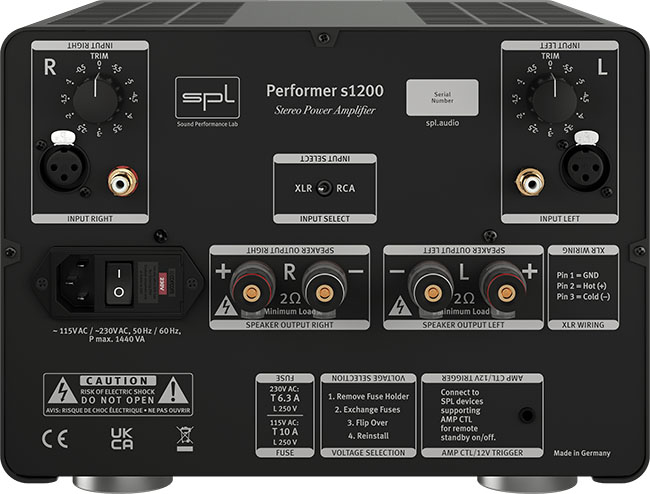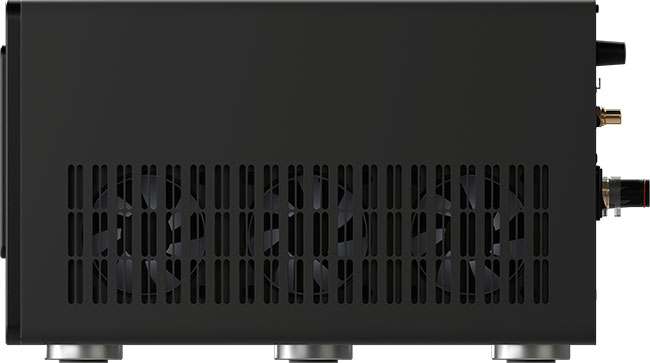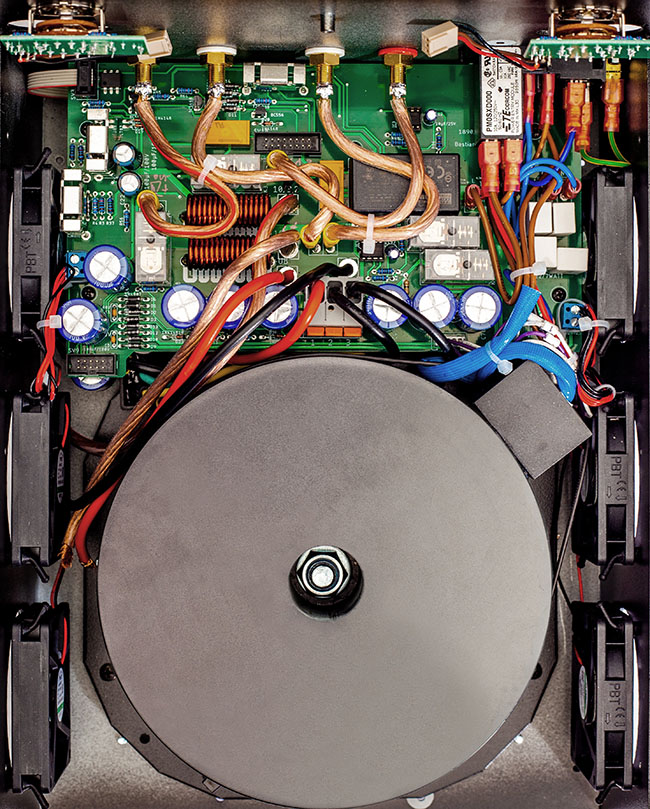SPL Performer s1200 stereo amplifier by Terry London

 I have participated in the high-end audio hobby for close to five decades. The great majority of that time was spent as a passionate audiophile pursuing the finest equipment to put in my system to create the illusion of live music in my listening space. For the last ten years, I took on the role of “professional reviewer,” which has been quite enjoyable in finding new equipment/companies and sharing this information with readers to help them find what they want in their systems to enhance the pleasure of the music they love.
I have participated in the high-end audio hobby for close to five decades. The great majority of that time was spent as a passionate audiophile pursuing the finest equipment to put in my system to create the illusion of live music in my listening space. For the last ten years, I took on the role of “professional reviewer,” which has been quite enjoyable in finding new equipment/companies and sharing this information with readers to help them find what they want in their systems to enhance the pleasure of the music they love.
Recently, I have had many discussions with readers regarding the topic that is often stated in the axiom, “Do you want truth or beauty in the sound of your system?” This dichotomous (either/or) proposition has a hint of truth regarding the evolution of solid-state amplifiers in the last thirty years. As I share in these conversations, personal taste accounts for a large percentage of what a serious listener experiences as “superlative” or “rotten,” and the same subjectivity goes for any reviewer’s opinion regarding the performance of gear they are evaluating, regardless if they use objective measurements in the reviewing process or not. After I explain my position regarding “personal taste,” I go on to share historically what solid-state amplifiers I have rated as some of the best. I then explain what sonic attributes I’m looking for in an amp’s performance that would allow me to relax and be engaged by the music experience. Historically, this list includes amplifiers from Threshold, Pass Labs, Coda Technology, Bricasti Design, and Sound Performance Labs. They all have excellent transparency/clarity, create large airy soundstages, location of individual images is spot-on, have very natural colors/timbres. They tend to have “meat on the bones” image density and an overall liquidity without a hint of dryness or grain. I have found these amplifiers to have that subjective quality of “musicality” that fits my taste. Many high-enders refer to these amplifiers as the “beauty” because they lack the last bit of resolution for their personal taste and sonic agenda, which does not allow the micro-details to shine through.
The leading edges of notes are slightly “fuzzy,” not as accurate as they should be. They experience the fullness of individual images and the vivid colors as an added coloration or a euphemism. These listeners often prefer amplifiers that provide the “truth,” nothing added, nothing subtracted to the signal that the Amplifier is given to reproduce. Amplifiers such as Boulder, Ayre, Soulution, Constellation, and D’Agostino would represent this type of presentation. Every time I have had these amplifiers in my system to review, based on my taste, I find them clean, clear, and dynamic, but never am I engaged or charmed by the music. Yes, individual sonic traits are admirable, such as great extended accurate bass, laser-sharp pinpoint imaging, and easily heard decay trails. Yet, the way I experience this type of presentation is that it has an overall mechanical or artificial manner. As one of my listening partners once said, “this type of amplifier does everything right, except make music.” Hopefully, now that you know my taste regarding solid-state amplifiers, the context is set for the review of the SPL Performer s1200 stereo amplifier, which retails for $7,499.
 In my first Stereo Times review on the SPL (Sound Performance Labs) Elector preamplifier/s800 amplifier/m1000 monoblocks from 2020 (here), I explained how this 30-year old Germany based company had historically designed and hand-built gear for the professional recording industry. I then shared that SPL had started producing high-end gear for the audiophile market in the last five years. The performance of the Elector preamplifier and the s800 amplifier was so superlative, and the pricing so reasonable I put them on the Stereo Times “MOST WANTED COMPONENTS” list for 2020. I found the performance of the m1000 monoblocks to be at quite a high level. However, I found the smaller single-chassis s800 Amplifier to have a “smidgeon” more warmth/intimacy in the midrange and slightly more three-dimensional imaging across all frequencies. It reminded me very much of my Pass Labs XA-25, but with much more power and a lower noise floor. In my correspondence with Hermann Gier, designer and managing partner of SPL, he shared his excitement regarding a new single-chassis stereo amplifier that would be twice the power of the s800, keep the “magic” I heard in the s800 midrange, along with adding some improvements in its overall performance. It took almost a year and a half to get the Performer s1200 amplifier in-house for review, but it was completely worth the wait. The s1200 is housed in the same chassis as the m1000 monoblocks. It retains a unique aesthetic function taken from the m1000 monoblocks. In the middle of the chassis is a shallow trough that allows you to insert either a sliver, red, or black faceplate. The s1200 shipped to me was clad in a black chassis. Underneath this faceplate is three LEDs that monitor on/off, temperature, and DC protection mode. Around the back, there are high-quality gold-plated speaker wire connections, two gain term pots, RCA/XLR inputs, and the ICE input. The Performer s1200, weighs 55 pounds, is an A/AB design, will produce 520 watts into 4 Ohms, 550 watts into 2 Ohms, and 300 watts into 8 Ohms. The s1200 Amplifier is based on the proprietary design called the VOLTAiR technology, which operates on an unrivaled +/-60 volt loading compared to the standard +/-15 volt loading. If you want to read more about the advantages of SPL’s VOLTAiR proprietary design, I suggest you go to their website for all the details.
In my first Stereo Times review on the SPL (Sound Performance Labs) Elector preamplifier/s800 amplifier/m1000 monoblocks from 2020 (here), I explained how this 30-year old Germany based company had historically designed and hand-built gear for the professional recording industry. I then shared that SPL had started producing high-end gear for the audiophile market in the last five years. The performance of the Elector preamplifier and the s800 amplifier was so superlative, and the pricing so reasonable I put them on the Stereo Times “MOST WANTED COMPONENTS” list for 2020. I found the performance of the m1000 monoblocks to be at quite a high level. However, I found the smaller single-chassis s800 Amplifier to have a “smidgeon” more warmth/intimacy in the midrange and slightly more three-dimensional imaging across all frequencies. It reminded me very much of my Pass Labs XA-25, but with much more power and a lower noise floor. In my correspondence with Hermann Gier, designer and managing partner of SPL, he shared his excitement regarding a new single-chassis stereo amplifier that would be twice the power of the s800, keep the “magic” I heard in the s800 midrange, along with adding some improvements in its overall performance. It took almost a year and a half to get the Performer s1200 amplifier in-house for review, but it was completely worth the wait. The s1200 is housed in the same chassis as the m1000 monoblocks. It retains a unique aesthetic function taken from the m1000 monoblocks. In the middle of the chassis is a shallow trough that allows you to insert either a sliver, red, or black faceplate. The s1200 shipped to me was clad in a black chassis. Underneath this faceplate is three LEDs that monitor on/off, temperature, and DC protection mode. Around the back, there are high-quality gold-plated speaker wire connections, two gain term pots, RCA/XLR inputs, and the ICE input. The Performer s1200, weighs 55 pounds, is an A/AB design, will produce 520 watts into 4 Ohms, 550 watts into 2 Ohms, and 300 watts into 8 Ohms. The s1200 Amplifier is based on the proprietary design called the VOLTAiR technology, which operates on an unrivaled +/-60 volt loading compared to the standard +/-15 volt loading. If you want to read more about the advantages of SPL’s VOLTAiR proprietary design, I suggest you go to their website for all the details.
After the review, I purchased the SPL s800 to become one of the solid-state amplifiers I used in my different systems. Luckily, I could easily exchange the s800 for the s1200. I also decided to use the same musical selections I used in the original SPL review. These three musical selections were: 1) Marty Paich’s “The Picasso of Big Band.” 2), Ben Paterson’s “For Once in My Life.” and 3), Jimmy Heath’s “Love Letters.”


Now, I understand the excitement of Hermann Gier and his design staff about their new creation, the s1200 Amplifier. With the s1200 inserted in the system that the s800 had driven, these are the improvements I could easily detect compared to the s800 Amplifier. The s1200 retains all the beautiful warmth/intimacy of the all-important midrange band. The three-dimensional imaging has been kept at the same level. Both these sonic attributes present very much like a reference level tube-based amplifier. Now add on a much more open, airy, refined top-end which adds a natural “sparkle” that blends perfectly with the upper mid-range. The s800 is one of the quietest amplifiers I have ever had in-house. However, the s1200’s noise floor, I believe, is even lower. This allows even more micro-details to be heard, and the ambient cues of the original recording space fill out the space, so the soundstage seems more open and natural. Finally, the S1200 Amplifier creates a much more extended, powerful, and controlled bottom-end foundation than its smaller sibling. The bass frequencies are taut and accurate in their timbres/tonality.


 None of these wonderful improvements in the s1200 Amplifier, compared to the s800 Amplifier, make the smaller sibling null and void. It’s still a great piece and a bargain for its price category. The up-charge in price is significant, going from the s800 to the s1200. However, based on the high-quality German engineering that the s1200 can deliver 550 watts into 4 Ohms to effortlessly drive any speaker load, this powerhouse amplifier is relatively small and lightweight, runs cool even at high dB volume, and most importantly, its musical performance makes the s1200’s price very reasonable.
None of these wonderful improvements in the s1200 Amplifier, compared to the s800 Amplifier, make the smaller sibling null and void. It’s still a great piece and a bargain for its price category. The up-charge in price is significant, going from the s800 to the s1200. However, based on the high-quality German engineering that the s1200 can deliver 550 watts into 4 Ohms to effortlessly drive any speaker load, this powerhouse amplifier is relatively small and lightweight, runs cool even at high dB volume, and most importantly, its musical performance makes the s1200’s price very reasonable.
And what about the s1200 Amplifier’s musical performance, going back to the introduction of my review regarding my taste and what I’m looking for in an amplifier’s delivery, that makes this German piece so special? The SPL s1200 amplifier is a gorgeous synthesis of the “truth and beauty.” It offers the beautiful tonality/timbres and warmth of instruments as they sound in real life, wonderful “meat on the bones” imaging, see-through transparency that allows all the micro-details to shine through, excellent bass extension and control, and overall liquidity that allows you to relax and easily be engaged in the music. The SPL s1200 is not leaving my house; I’ll purchase the review demo.


terry london
Specifications
Price: $7,499.00 USA
Analog Inputs: XLR (balanced), RCA (unbalanced)
Input impedance: 20 kΩ
Input trimming: 0 dB to -5.5 dB in 0.5 dB steps
Input sensitivity: 10,5 dBu
Loudspeaker Outputs: Binding posts with 4 mm ø cable hole (screwable) and banana plug
Output power (RMS, 2 Ω) 2 x 550 W
Harmonic distortion (1 kHz, 2 Ω) < 0,09 %
Output power (RMS, 4 Ω): 2 x 520 W
Harmonic distortion (1 kHz, 4 Ω) < 0,09 %
Output power (RMS, 8 Ω): 2 x 300 W
Harmonic distortion (1 kHz, 8 Ω): < 0,04 %
Output voltage (Peak-to-Peak): 160 V
Output voltage (RMS): 54,6 V
Output impedance (20 Hz – 20 kHz): < 0,031 Ω
Frequency range (-3dB): 10 Hz – 80 kHz
Amplification gain: 26 dB
Damping factor (1 kHz, 8 Ω): > 290
Noise (A-weighted): -123 dB
Internal Linear Power Supply with Shielded Toroidal Transformer
Toroidal transformer: 1440 VA
Operating voltage (Input stage): +/- 60 V
Operating voltage (power stage): +/- 80 V
Operating voltage for relays, LEDs, AMP CTL: + 12 V
Mains Power Supply
Mains voltage (selectable, see fuse chamber)
230 V AC / 50; 115 V AC / 60 Hz
Fuse 230 V: T 6,3 A
Fuse 115 V: T 10 A
Power consumption: max. 1440 VA
Idle power consumption: 50 W
Stand-by power consumption: < 0,3 W
Dimensions & Weight: W x H x D (width x height incl. feet x depth)
278 x 205 x 375 mm,10.94 x 8.07 x 14.76 inch
Unit weight: 25,1 kg, 55,3 lbs
Shipping weight: 29,1 kg, 64,2 lbs
Reference: 0 dBu = 0,775V. All specifications are subject to change without notice.
Website www.splaudio.com
Terry’s Associated Equipment
Sources:
Pass Labs DAC -1
Audio Note UK Balanced 3.1 MK-II DAC
Pro-Ject reference transport
CEC MK-II CD transport
Amplification:
Coda FET 07x preamplifier
SPL Elector preamplifier
AricAudio Motherlode MK-II preamplifier
Coda # 16 amplifier
Threshold 550e amplifier
AricAudio Super SET 300b amplifier
Pass Labs XA-25 amplifier
Loudspeakers:
Tekton Design Ulfberth & Perfect SET
NSMT Model 100
NSMT band pass subwoofers
Sonus Faber Cremona M Monitor
Accessories:
Full Loom of Black Cat cables- Digit 110 AES/EBU-3202 XLR IC’s-3232 speaker wire
Kirmuss Adrenaline speaker wire
Krolo Design reference rack & footers
Puritan Audio Labs- Ground master system & conditioner
Audio Archon power cords
One thought on "SPL Performer s1200 stereo amplifier by Terry London"
Leave a Reply
Stereo Times Masthead
Publisher/Founder
Clement Perry
Editor
Dave Thomas
Senior Editors
Frank Alles, Mike Girardi, Key Kim, Russell Lichter, Terry London, Moreno Mitchell, Paul Szabady, Bill Wells, Mike Wright, Stephen Yan, and Rob Dockery
Current Contributors
David Abramson, Tim Barrall, Dave Allison, Ron Cook, Lewis Dardick, Dan Secula, Don Shaulis, Greg Simmons, Eric Teh, Greg Voth, Richard Willie, Ed Van Winkle, and Rob Dockery
Music Reviewers:
Carlos Sanchez, John Jonczyk, John Sprung and Russell Lichter
Site Management Clement Perry
Ad Designer: Martin Perry







You haven’t mentioned the gain trim pots on these SPL amps, nor described their function or performance. These are unique features of these amps, from my perspective, and I’m curious what they add to the performance of the amp.